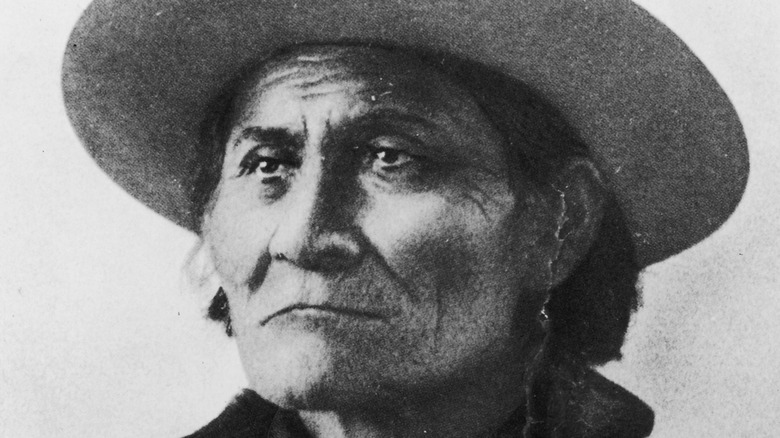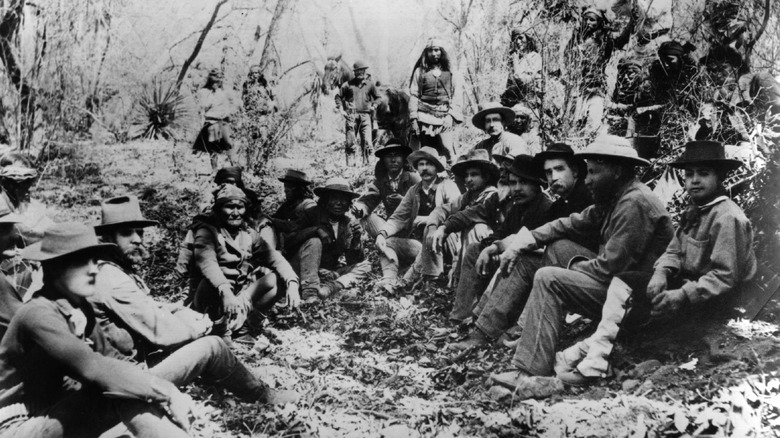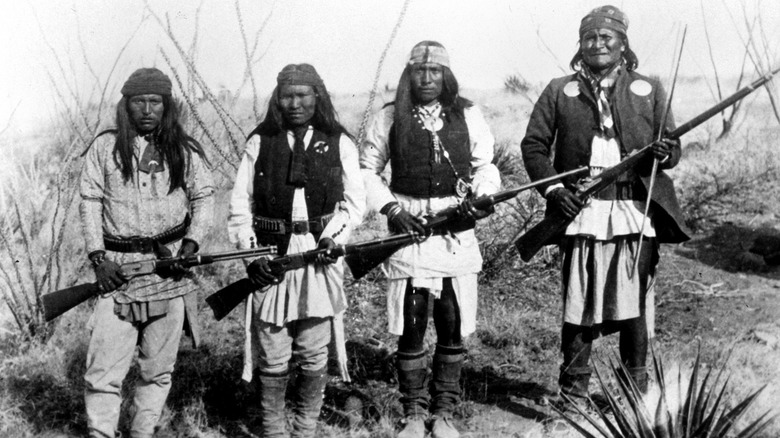The True Cause Of Geronimo's Quest For Revenge
The legendary Geronimo, an Apache leader, and medicine man, is one of the most famous Native Americans in United States history. Indigenous populations lived in North America for centuries before the Europeans came and, as with most stories of Native American history in the U.S., his is one of heroism and bravery, yet marked by tragedy, rage, and, ultimately, sadness. He was born in 1829 in what is now the upper Gila River country in Arizona into the small Bedonkohe band of the Chiricahua tribe and came of age as the U.S. government was expanding into the Southwest during the Mexican-American War of the 1840s (via History). Geronimo ultimately represented a symbol of resistance to both the Mexican and American military, conducting raids and waging warfare for more than 30 years between 1850 and 1886 when he finally surrendered, according to the University of Michigan Library's Great Native American Chiefs.
One could argue that Geronimo fought for so long and so hard to save his ancestral home from the white settlers who were flooding onto Apache lands after Mexico ceded vast swaths of the southwest to the U.S. government with the Treaty of Guadalupe Hidalgo, which ended the war between the two sides, according to the National Archives. However, one of the greatest tragedies in Geronimo's life was the massacre of his family and some historians contend this is what changed the direction of the rest of his life.
Geronimo Exacts Revenge For Family Massacre
The Apaches had frequent disputes with their neighbors the Navajo and Comanches, and the Mexicans to the South before the American government (via History), but Geronimo was never the same after his wife, their three children, and his mother were killed in an attack in 1851 by the Mexican military while he was away from camp, according to Geronimo's 1905 biography, Smithsonian reported.
Geronimo was grief-stricken with the death of his family. He burned his family's possessions, in keeping with Apache tradition, and headed into the wilderness where he grieved his losses until one day he heard a voice. The voice told him, "No gun will ever kill you. I will take the bullets from the guns ... and I will guide your arrows" (via Biography). With that, Geronimo set out with a small band of 200 Apaches. They spent the next ten years tracking down and killing every Mexican involved in the attack on his family, exacting a painful revenge against the Mexican military and avenging his family, and they continued to raid Mexican towns and military camps for another decade.
Geronimo Continues The Fight
By the 1870s, Geronimo was known as a fearless leader and he continued his battle, this time against the American military which had created a reservation for the Chiricahua in 1872, at first on part of their homeland in Arizona, then evicting the tribe and forcing them to join other Apaches at the San Carlos Reservation (via History). Geronimo escaped the reservation several times over the next decade and eluded U.S. troops, but in 1886 he finally surrendered. He was treated as a U.S. war criminal until his death at Fort Sill in Oklahoma in 1909.
His followers saw him as "the last great defender of the Native American way of life," according to Biography, but others, including some Apaches, saw him as foolish, a hold-out, putting lives in jeopardy. Either way, Geronimo is remembered by history as one of the last great Native American leaders, fighting against all odds for his homeland, and to keep his people free.


